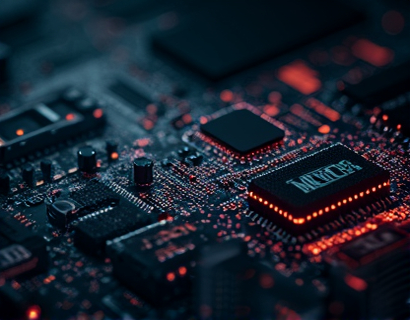Unlocking Blockchain Scalability: Advanced Layer 2 Solutions for EVM-Enabled Development
In the rapidly evolving landscape of blockchain technology, scalability has emerged as a critical challenge for developers and innovators. The Ethereum Virtual Machine (EVM) has been a cornerstone for decentralized applications (dApps) and smart contracts, but its inherent limitations in transaction throughput and processing speed have necessitated the exploration of advanced Layer 2 (L2) solutions. These solutions aim to enhance scalability, security, and efficiency, paving the way for faster, more secure, and cost-effective decentralized applications. This article delves into the intricacies of L2 solutions specifically tailored for EVM-enabled development, highlighting their transformative potential in blockchain innovation.
Understanding the EVM and Its Limitations
The EVM is a runtime environment for smart contracts, enabling the execution of code in a trustless and decentralized manner. While it has been instrumental in the growth of decentralized finance (DeFi), non-fungible tokens (NFTs), and other blockchain applications, its design imposes significant constraints. The EVM processes transactions in a sequential manner, leading to bottlenecks as network usage increases. Each transaction requires gas, a unit of measurement for computational effort, which can become prohibitively expensive during peak times. Moreover, the block time on Ethereum is approximately 13 seconds, limiting the number of transactions that can be processed per second.
These limitations have spurred the development of Layer 2 solutions, which operate on top of the primary blockchain (Layer 1) to offload some of the computational load. L2 solutions do not rewrite the blockchain's core protocol but instead enhance its capabilities by introducing new layers that can process transactions more efficiently. For EVM-enabled development, these solutions offer a pathway to overcome the scalability hurdles while maintaining the security and decentralization that Ethereum provides.
Types of Layer 2 Solutions
Several L2 solutions have been proposed and implemented to address the scalability issues of the EVM. These can be broadly categorized into state channels, sidechains, and rollups. Each type has its unique approach and advantages, making them suitable for different use cases in EVM-based blockchain development.
State Channels
State channels allow multiple parties to conduct a series of transactions off the main blockchain, with the final state being submitted to the blockchain once the channel is closed. This method significantly reduces the number of transactions that need to be processed on the EVM, thereby lowering gas costs and increasing transaction speed. For EVM-enabled dApps, state channels are particularly useful for applications that involve frequent, low-value transactions, such as gaming or micropayments. However, state channels require all participants to be online simultaneously, which can be a limitation for certain use cases.
Sidechains
Sidechains are independent blockchains that are linked to the main blockchain through a two-way peg. They allow assets to be transferred between the main chain and the sidechain, enabling more flexible and scalable transaction processing. For EVM-based development, sidechains can offload a significant portion of the transaction load, improving overall network performance. However, the security of sidechains depends on the implementation and the trust in the peg mechanism, which can be a concern for some developers.
Rollups
Rollups are one of the most promising L2 solutions for scaling the EVM. They come in two main varieties: Optimistic Rollups and ZK Rollups. Optimistic Rollups bundle multiple transactions into a single transaction on the main chain, with a challenge period to verify the validity of the transactions. If no challenge is raised, the transaction is considered valid. This approach can process thousands of transactions per second while maintaining security through the EVM's trustless nature. ZK Rollups, on the other hand, use zero-knowledge proofs to bundle and verify transactions off-chain, submitting a compact proof to the main chain. This method offers even higher throughput and faster finality but requires more complex cryptographic techniques.
Rollups are particularly advantageous for EVM-enabled dApps as they preserve the security and decentralization of the main chain while significantly enhancing scalability. They are ideal for applications that require high transaction volumes, such as DeFi protocols and NFT marketplaces. The efficiency gains from rollups can lead to lower gas fees and faster transaction times, making decentralized applications more accessible and user-friendly.
Enhancing Security and Efficiency
While scalability is a primary concern, security and efficiency are equally critical in L2 solutions for EVM-based development. Advanced L2 technologies ensure that the benefits of scalability do not come at the expense of security. For instance, rollups maintain the EVM's trustless execution environment, ensuring that smart contracts remain secure and immutable. The use of cryptographic proofs in ZK Rollups further enhances security by providing a verifiable guarantee of transaction validity without the need for full state replication.
Efficiency is another key aspect, as L2 solutions reduce the computational load on the EVM. By offloading transactions to a secondary layer, the main chain can focus on critical operations, leading to faster block times and lower gas costs. This efficiency is particularly beneficial for resource-intensive applications, such as complex DeFi protocols and large-scale NFT projects, which can now operate smoothly without the constraints of high gas prices and slow transaction times.
Case Studies and Real-World Applications
The practical implementation of L2 solutions in EVM-enabled development can be seen in various real-world applications. For example, several DeFi platforms have adopted rollup solutions to handle high volumes of trades and transactions. These platforms have reported significant reductions in gas fees and transaction times, making their services more accessible to a broader user base. Similarly, NFT marketplaces have leveraged L2 solutions to facilitate the creation, trading, and management of digital assets with minimal latency and cost.
Another notable application is in the realm of gaming, where state channels and rollups have enabled seamless in-game transactions and asset management. These solutions allow for real-time interactions and dynamic game states without the delays and high costs associated with on-chain transactions. The enhanced user experience has led to increased engagement and adoption of blockchain-based games.
Future Prospects and Challenges
The future of blockchain scalability is bright, with ongoing research and development pushing the boundaries of what is possible. For EVM-enabled development, the integration of advanced L2 solutions is set to become increasingly prevalent. However, several challenges remain, including the need for interoperability between different L2 layers and the main chain, as well as the complexity of implementing and maintaining these solutions.
Interoperability is crucial for creating a seamless ecosystem where users can seamlessly transition between on-chain and off-chain environments. Standardization efforts and collaborative initiatives among developers and blockchain projects are essential to address this challenge. Additionally, the complexity of L2 solutions requires robust development tools and best practices to ensure secure and efficient implementation.
Despite these challenges, the potential benefits of L2 solutions are driving significant investment and innovation. As the blockchain community continues to refine and optimize these technologies, we can expect to see even more powerful and user-friendly decentralized applications in the future. The combination of scalability, security, and efficiency will be key drivers of blockchain adoption across various industries, from finance and gaming to supply chain and beyond.
Conclusion
Advanced Layer 2 solutions represent a transformative step forward in EVM-enabled blockchain development. By addressing the scalability limitations of the EVM, these solutions enhance the performance, security, and cost-effectiveness of decentralized applications. Whether through state channels, sidechains, or rollups, L2 technologies offer a versatile toolkit for developers to build faster, more secure, and more efficient dApps. As the blockchain ecosystem continues to evolve, the integration of these solutions will play a pivotal role in shaping the future of decentralized technology.










































